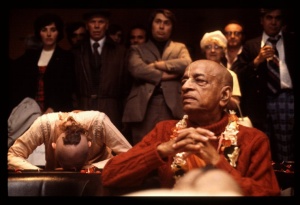SB 9.5.6

A.C. Bhaktivedanta Swami Prabhupada
TEXT 6
- namaḥ sunābhākhila-dharma-setave
- hy adharma-śīlāsura-dhūma-ketave
- trailokya-gopāya viśuddha-varcase
- mano-javāyādbhuta-karmaṇe gṛṇe
SYNONYMS
namaḥ — all respectful obeisances unto you; su-nābha — O you who have an auspicious hub; akhila-dharma-setave — whose spokes are considered to be a breech of the entire universe; hi — indeed; adharma-śīla — who are irreligious; asura — for the demons; dhūma-ketave — unto you who are like fire or an inauspicious comet; trailokya — of the three material worlds; gopāya — the maintainer; viśuddha — transcendental; varcase — whose effulgence; manaḥ-javāya — as speedy as the mind; adbhuta — wonderful; karmaṇe — so active; gṛṇe — I simply utter.
TRANSLATION
O Sudarśana, you have a very auspicious hub, and therefore you are the upholder of all religion. You are just like an inauspicious comet for the irreligious demons. Indeed, you are the maintainer of the three worlds, you are full of transcendental effulgence, you are as quick as the mind, and you are able to work wonders. I can simply utter the word namaḥ, offering all obeisances unto you.
PURPORT
The disc of the Lord is called Sudarśana because he does not discriminate between high and low criminals or demons. Durvāsā Muni was certainly a powerful brāhmaṇa, but his acts against the pure devotee Mahārāja Ambarīṣa were no better than the activities of asuras. As stated in the śāstras, dharmaṁ tu sākṣād bhagavat-praṇītam: (SB 6.3.19) the word dharma refers to the orders or laws given by the Supreme Personality of Godhead. Sarva-dharmān parityajya mām ekaṁ śaraṇaṁ vraja: (BG 18.66) real dharma is surrender unto the Supreme Personality of Godhead. Therefore real dharma means bhakti, or devotional service to the Lord. The Sudarśana cakra is here addressed as dharma-setave, the protector of dharma. Mahārāja Ambarīṣa was a truly religious person, and consequently for his protection the Sudarśana cakra was ready to punish even such a strict brāhmaṇa as Durvāsā Muni because he had acted like a demon. There are demons even in the form of brāhmaṇas. Therefore the Sudarśana cakra does not discriminate between brāhmaṇa demons and śūdra demons. Anyone against the Supreme Personality of Godhead and His devotees is called a demon. In the śāstras we find many brāhmaṇas and kṣatriyas who acted as demons and have been described as demons. According to the verdict of the śāstras, one has to be understood according to his symptoms. If one is born of a brāhmaṇa father but his symptoms are demoniac, he is regarded as a demon. The Sudarśana cakra is always concerned with annihilating the demons. Therefore he is described as adharma-śīlāsura-dhūma-ketave. Those who are not devotees are called adharma-śīla. The Sudarśana cakra is just like an inauspicious comet for all such demons.